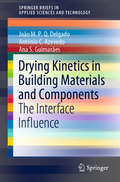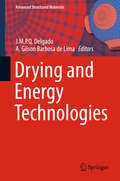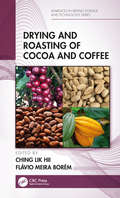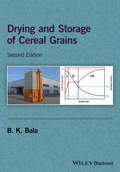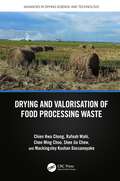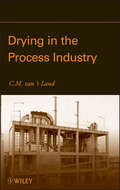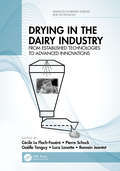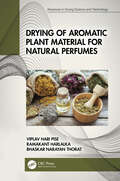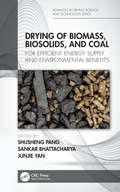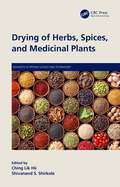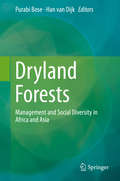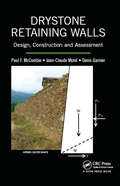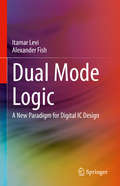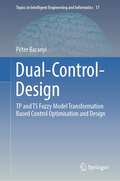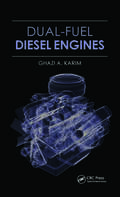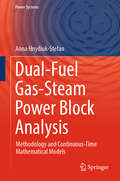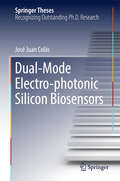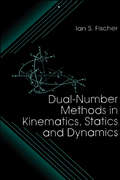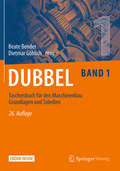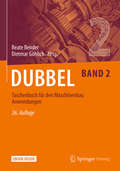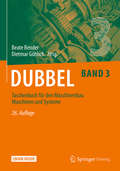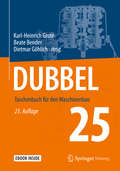- Table View
- List View
Drying Kinetics in Building Materials and Components: The Interface Influence (SpringerBriefs in Applied Sciences and Technology)
by Ana S. Guimarães António C. Azevedo João M. DelgadoThis work presents an extensive experimental characterisation of two different ceramic brick blocks with different interface, at different heights, during the drying process. First, a laboratory characterization of the building material used (ceramic bricks and different mortars) is presented, showing their hygrothermal, mechanical and thermal properties, namely, bulk porosity and density, water vapour permeability, capillary absorption, retention curve, moisture diffusivity as a function of moisture content and thermal conductivity. Moreover, the moisture transfer in multi-layered systems was analysed in detail taking into account the interface contact between the building elements.
Drying and Energy Technologies
by J.M.P.Q. Delgado A. Gilson Barbosa de LimaThis book provides a comprehensive overview of essential topics related to conventional and advanced drying and energy technologies, especially motivated by increased industry and academic interest. The main topics discussed are: theory and applications of drying, emerging topics in drying technology, innovations and trends in drying, thermo-hydro-chemical-mechanical behaviors of porous materials in drying, and drying equipment and energy. Since the topics covered are inter-and multi-disciplinary, the book offers an excellent source of information for engineers, energy specialists, scientists, researchers, graduate students, and leaders of industrial companies. This book is divided into several chapters focusing on the engineering, science and technology applied in essential industrial processes used for raw materials and products.
Drying and Roasting of Cocoa and Coffee (Advances in Drying Science and Technology)
by Ching Lik Hii Flávio Meira BorémThis is the first practical book dedicated to the fundamental and application aspects of two major unit operations in cocoa and coffee processing, namely drying and roasting. The drying and roasting of cocoa and coffee beans play critical roles in governing the formation of flavor precursors in the early stages and also the development of flavor and aroma in the later stages during processing. Hence, qualities of the finished chocolates and coffee powder products are affected greatly by the dried and roasted beans produced. Drying and Roasting of Cocoa and Coffee covers key topics areas ranging from post-harvest processing, equipment selection, physical and chemical changes during processing, flavor development, grading and dried product quality. The book consists of two parts with topics dedicated to the drying/roasting aspects of cocoa and coffee, respectively. Features Provides a comprehensive review on flavor development during cocoa/coffee processing Discusses the impact of processing parameters on cocoa/coffee quality Presents the new trends in drying/roasting techniques and novel technology Examines the concept of coffee quality in light of both paradigms: the traditional coffee and the specialty coffee grading systems No prior knowledge of cocoa and coffee processing is required to benefit from this book, which is written for a variety of readers. It is suitable for undergraduate and postgraduate students, researchers and industrial practitioners/consultants from various domains in the food and beverage industries.
Drying and Storage of Cereal Grains
by B. K. BalaFinite Element Analysis and Computational Fluid Dynamics have been introduced in modelling and simulation of drying and storage systems, these techniques are expected to dominate the future research and development of drying and storages, and should reduce losses and improve the quality of agricultural products, enhancing food security globally. Drying and Storage of Cereal Grains, Second Edition, covers the wide spectrum of drying and storage methods applied to economically important cereal produce, providingnumerical examples for better understanding the complexity in drying and storage systems through modelling and simulation, aiding design and management of drying and storage systems. Chapters 1 to 8 look at air and grain moisture equilibria, psychrometry, physical and thermal properties of cereal grains, principles of air flow, and provide detailed analyses of grain drying.Chapters 9 to 13 focus on temperature and moisture in grain storages, and provide comprehensive treatment of modern grain storage systems. The book also includes a number of unsolved problems at the end of each chapter for further practice. This revised second edition includes new sections on - * heat of sorption * finite element modeling of single kernel * CFD modeling of fluidized bed drying * exergy analysis and neural network modeling* numerical solution of two dimensional temperature and moisture changes in stored grain This book will provide students in agricultural engineering and food engineering with a wide spectrum of drying and storage studies previously unavailable in a single monograph. It will also serve as an excellent reference for practicing agricultural engineers, food engineers and food technologists.
Drying and Valorisation of Food Processing Waste (Advances in Drying Science and Technology)
by Chien Hwa Chong Rafeah Wahi Chee Ming Choo Shee Jia Chew Mackingsley Kushan DassanayakeDrying and Valorisation of Food Processing Waste is a comprehensive guide that delves into the crucial role of advanced drying technologies in mitigating the issue of food waste. This book evaluates the current research, technologies, and methodologies in food waste processing and valorisation, highlighting the challenges and opportunities that exist in this field. This book provides a systematic classification of various types of food waste and how to choose the most appropriate drying technology based on waste characteristics. It also covers the effects of drying technologies on physical and chemical properties, as well as valuable compounds. In addition, it evaluates the impact of drying on different valorisation routes and provides real-life industrial case studies to illustrate the practical applications of the concepts discussed. It is an invaluable resource for professionals, researchers, and academics who are looking to gain a deeper understanding of the impact of drying on food waste reduction and valorisation. This book is aimed at chemical, food, and environmental engineers as well as researchers and academics in these fields. It provides a comprehensive overview of the latest developments in food waste processing and valorisation and is an essential reference for professionals seeking to advance their knowledge in this field. Additionally, this book's practical approach and case studies make it an ideal resource for students and researchers who are looking to gain hands-on experience in food waste reduction and valorisation.
Drying in The Process Industry
by C.M. van't LandA comprehensive approach to selecting and understanding drying equipment for chemical and mechanical engineers A detailed reference of interest for engineers and energy specialists working in the process industry field, Drying in the Process Industry investigates the current state of the art of today's industrial drying practices, examines the factors influencing drying's high costs in both equipment and energy consumption, and summarizes key elements for keeping drying operations under budget and performing at peak capacity safely while respecting the environment. Extensive coverage of dryer basics as well as essential procedures concerning the selection of industrial dryers-such as how to gather results of relevant laboratory measurements, carry out small-scale tests, and correctly size equipment-help to inform readers on criteria for generating scalable specifications that greatly assist buying decisions. Drying in the Process Industry: Takes a practical approach to drying equipment, from an author with four decades in the industry Describes a diverse array of drying equipment (convective, like flash, spray, fluid-bed, and rotary; contact, like paddle and steam; radiation) from an engineer's perspective Provides quick and ready access to drying technologies with references to more detailed literature Treats drying in the context of the entire production process True of all process facilities where drying plays an important role, such as those in the chemical, pharmaceutical, plastics, and food industries, the purchase of improper industrial drying equipment can significantly affect a manufacturer's economic bottom line. With the guidance offered in this book, engineers will be able to confidently choose industrial drying equipment that increases profits, runs efficiently, and optimally suits their needs.
Drying in the Dairy Industry: From Established Technologies to Advanced Innovations (Advances in Drying Science and Technology)
by CécilePierreGaëlleLucaRomain Le Floch-Fouéré Schuck Tanguy Lanotte JeantetWith more than 12M tons of dairy powders produced each year at a global scale, the drying sector accounts to a large extent for the processing of milk and whey. It is generally considered that 40% of the dry matter collected overall ends up in a powder form. Moreover, nutritional dairy products presented in a dry form (eg, infant milk formulae) have grown quickly over the last decade, now accounting for a large share of the profit of the sector. Drying in the Dairy Industry: From Established Technologies to Advanced Innovations deals with the market of dairy powders issues, considering both final product and process as well as their interrelationships. It explains the different processing steps for the production of dairy powders including membrane, homogenisation, concentration and agglomeration processes. The book includes a presentation of the current technologies, the more recent development for each of them and their impact on the quality of the final powders. Lastly, one section is dedicated to recent innovations and methods directed to more sustainable processes, as well as latter developments at lab scale to go deeper in the understanding of the phenomena occurring during spray drying. Key Features: Presents state-of-the-art information on the production of a variety of different dairy powders Discusses the impact of processing parameters and drier design on the product quality such as protein denaturation and viability of probiotics Explains the impact of drying processes on the powder properties such as solubility, dispersibility, wettability, flowability, floodability, and hygroscopicity Covers the technology, modelling and control of the processing steps This book is a synthetic and complete reference work for researchers in academia and industry in order to encourage research and development and innovations in drying in the dairy industry.
Drying of Aromatic Plant Material for Natural Perfumes (Advances in Drying Science and Technology)
by Bhaskar Narayan Thorat Viplav Hari Pise Ramakant HarlalkaDrying of Aromatic Plant Material for Natural Perfumes provides readers with a deep understanding of the fascinating world of aromatic plants, drying, extraction and perfumery. It covers the significance and global demand of essential oils, a glimpse of plant histology, secretion and storage of secondary metabolites in plant tissues, drying technologies and selection for dehydration of herbage, extraction, chemical compositions and applications. The book is organized into four sections: plant cell structures and their role during dehydration, aromatic plants and their essential oil contents, composition and contribution towards perfumery, and dehydration and extraction technologies. The book does the following: Summarizes commercially important aromatic plant materials and extracted essential oil around the world and their socio-commercial impact Includes structures of plant tissues, inherent mass transfer pathways, along with the presence and role of water, the understanding of which can aid dehydration and extraction Describes methods for selecting drying parameters and relates drying mechanisms with microstructure Discusses drying technologies for heat-sensitive materials and extraction technologies for selective component extractions Covers preprocessing, extraction and standardization of essential oils for blending for different applications This book serves as a handy tool for R&D, industrial, and academic researchers working in perfumery, fragrance, and food science, as well as chemical and agricultural engineering.
Drying of Biomass, Biosolids, and Coal: For Efficient Energy Supply and Environmental Benefits (Advances in Drying Science and Technology)
by Shusheng Pang Sankar Bhattacharya Junjie YanDrying of Biomass, Biosolids, and Coal: For Efficient Energy Supply and Environmental Benefits provides insight into advanced technologies and knowledge of the drying of biomass, biosolids, and coal in terms of improved efficiency, economics, and environmental impact. It comprehensively covers all the important aspects of drying for a variety of biomass, biosolids and coal resources.This book covers the drying of biomass, bio-solids and coal while also providing integration of the drying process with the energy system. Important issues in the commercial drying operations are tackled, including energy and exergy efficiencies, environmental impact, and potential safety concerns. It also assesses the performance of energy production plants in integration with biomass/coal drying to provide information for plant optimization. It offers in-depth analysis and data for process understanding and design, and analyzes the drying process’s effect on economics and the environment.This book is aimed at drying professionals and researchers, chemical engineers, industrial engineers, and manufacturing engineers. It will also be of use to anyone who is interested in the utilization of biomass, organic solid wastes, algae and low-rank coals for energy.
Drying of Herbs, Spices, and Medicinal Plants (Advances in Drying Science and Technology)
by Ching Lik Hii Shivanand S. ShirkoleDrying is a key operation in processing of many plant-based foods and medicines for the purpose of preservation and retention of key attributes and active compounds. Therefore, it is essential to select suitable drying techniques to ensure a product is processed under optimal operating conditions. Drying of Herbs, Spices, and Medicinal Plants presents processing aspects of these three major global agricultural commodities. It offers an insight into the drying and product quality of herbs, spices, and medicinal plants, such as drying characteristics, equipment selection, physiochemical analyses, quality improvement, product development, storage, and shelf life as well as future developments. Offers the latest information on drying and processing technologies, research, and development Summarizes various drying techniques, their advantages and limitations, industrial applications, and simple design methods Presents guidelines for dryer selection Links theory and practice Envisages future trends and demands Featuring chapters from expert authors in both industry and academia, this book is an important resource for those working in the chemical, food processing, pharma, and biotech industries, especially those focused on the drying of plants for food and medicinal applications.
Dryland Forests
by Purabi Bose Han Van DijkThis volume provides new insights and conceptual understandings of the human and gender dimension of vulnerability in relation to the dynamics of tenure reforms in the dryland forests of Asia and Africa. The book analyzes the interaction between biophysical factors such as climate variability (e. g. droughts) with socio-political processes (e. g. new institutions and authority) and gender dimensions at various temporal and spatial scales. The book presents a number of case studies based on empirical research on forest tenure reform and it consequences on forest-dependent people. In particular, it highlights the interaction between legal, policy and institutional reform and the inclusion and/or exclusion of local people from deriving benefits from forest resources in the drylands. The book focuses on the questions how land tenure reform and natural resource governance impacts upon marginal groups (along individual, collective and gender dimensions); how do forest-dependent people prepare for and respond to vulnerability; and what is the effect of forest tenure policy reform on the human rights, gender and citizenship issues in relation to the use and management of forest resources and on conflict in forest zones. These issues are approached from the perspective of marginalized groups (gender and social diversity such as indigenous peoples and herders) in vulnerable dryland forests with a high risk of being exposed to climate variability.
Drystone Retaining Walls: Design, Construction and Assessment
by Paul F. McCombieTake a Detailed Look at the Practice of Drystone Retaining Wall ConstructionDrystone retaining walls make very efficient use of local materials, and sit comfortably in their environment. They make an important contribution to heritage and to the character of the landscape, and are loved by many people who value the skill and ingenuity that has gone
Du, roboter
by Daniel Canals FloresDu, roboter, bist eine ernste Warnung an die Menschheit. Beim Schreiben dieser Geschichte ging mir ein Schauer durch die Seele: Das Akronym I.A. (Künstliche Intelligenz) entsprechen denen des unbestrittenen Robotik-Genies Isaac Asimov. War dem Lehrer das bewusst? Dieses Buch ist eine Hommage an seine Arbeit und seine verstörende Zukunftsvision. Die vierte industrielle Revolution und der Egoismus einiger weniger werden das Monster hervorbringen, das am Ende das Universum beherrschen und die menschliche Spezies zerstören wird ...
Dual Mode Logic: A New Paradigm for Digital IC Design
by Alexander Fish Itamar LeviThis book presents Dual Mode Logic (DML), a new design paradigm for digital integrated circuits. DML logic gates can operate in two modes, each optimized for a different metric. Its on-the-fly switching between these operational modes at the gate, block and system levels provide maximal E-D optimization flexibility. Each highly detailed chapter has multiple illustrations showing how the DML paradigm seamlessly implements digital circuits that dissipate less energy while simultaneously improving performance and reducing area without a significant compromise in reliability. All the facets of the DML methodology are covered, starting from basic concepts, through single gate optimization, general module optimization, design trade-offs and new ways DML can be integrated into standard design flows using standard EDA tools. DML logic is compatible with numerous applications but is particularly advantageous for ultra-low power, reliable high performance systems, and advanced scaled technologies Written in language accessible to students and design engineers, each topic is oriented toward immediate application by all those interested in an alternative to CMOS logic.Describes a novel, promising alternative to conventional CMOS logic, known as Dual Mode Logic (DML), with which a single gate can be operated selectively in two modes, each optimized for a different metric (e.g., energy consumption, performance, size);Demonstrates several techniques at the architectural level, which can result in high energy savings and improved system performance;Focuses on the tradeoffs between power, area and speed including optimizations at the transistor and gate level, including alternatives to DML basic cells;Illustrates DML efficiency for a variety of VLSI applications.
Dual-Control-Design: TP and TS Fuzzy Model Transformation Based Control Optimisation and Design (Topics in Intelligent Engineering and Informatics #17)
by Péter BaranyiThe TP and TS Fuzzy model transformation based control design has revolutionized the field of control design by introducing a highly effective approach. Through the TP model transformation, it has become evident that the design of controllers and observers, as well as the effectiveness of applied LMIs, are greatly influenced by the shape of the antecedent Fuzzy sets and the number and location of the consequent systems.Furthermore, the TP model transformation has revealed that the sensitivity of controller and observer design differs in nature. This implies that the overseer and controller design require different TS Fuzzy model representations of the system at hand. This book offers a comprehensive exploration of this phenomenon.The book introduces several new theoretical advancements in the TP or TS Fuzzy model transformation based control design framework. It presents a complete framework for TP and TS Fuzzy model transformation and offers various tools based on this approach to enhance control design effectiveness. The book introduces novel theoretical concepts, such as interpolation between alternative TS Fuzzy model representations, which leads to a new optimization framework. It also explores methods to achieve further complexity reduction beyond rank minimization. Additionally, the book addresses the execution of TS Fuzzy model transformation for large-sized problems and demonstrates how to reinforce various properties of antecedent Fuzzy sets through manipulation.Practical hints and guidance for control design is provided throughout the book, with examples illustrating the application of novel solutions. Matlab codes are also included to facilitate the implementation of the proposed methods.
Dual-Fuel Diesel Engines
by Ghazi A. KarimDual-Fuel Diesel Engines offers a detailed discussion of different types of dual-fuel diesel engines, the gaseous fuels they can use, and their operational practices. Reflecting cutting-edge advancements in this rapidly expanding field, this timely book:Explains the benefits and challenges associated with internal combustion, compression ignition,
Dual-Fuel Gas-Steam Power Block Analysis: Methodology And Continuous-time Mathematical Models (Power Systems)
by Anna Hnydiuk-StefanThis book presents the methodology and mathematical models for dual-fuel coal-gas power plants in two basic configurations: systems coupled in parallel and in series.Dual-fuel gas and steam systems, especially parallel systems, have great potential for modernizing existing combined heat and power (CHP) plants. This book presents calculations using a novel methodology applied to systems in continuous time and analyzes the impact of the investment profitability of the EU ETS (European Union Emissions Trading Scheme) derogation mechanism, which encourages enterprises to modernize existing generation units. It also includes a detailed case study of a coal power plant modernized by repowering with a gas turbine.The book is intended for researchers, market analysts, decision makers, power engineers and students.
Dual-Mass Linear Vibration Silicon-Based MEMS Gyroscope
by Huiliang CaoThis book introduces the key technologies in the manufacture of double-mass line vibrating silicon micromechanical gyroscope, respectively. The design of gyrostructure, detection technology, orthogonal correction technology, the influence of temperature and the design of measurement and control system framework are introduced in detail, with illustrations for easy understanding. It presents the principle, structure and related technology of silicon-based MEMS gyroscope. The content enlightens the researchers of silicon-based MEMS gyroscopes and gives readers a new understanding of the structural design of silicon-based gyroscopes and the design of dual-mass gyroscopes.
Dual-Mode Electro-photonic Silicon Biosensors
by José Juan ColásThis highly interdisciplinary thesis reports on two innovative photonic biosensors that combine multiple simultaneous measurements to provide unique insights into the activity and structure of surface immobilized biological molecules. In addition, it presents a new silicon photonic biosensor that exploits two cascaded resonant sensors to provide two independent measurements of a biological layer immobilized on the surface. By combining these two measurements, it is possible to unambiguously quantify the density and thickness of the molecular layer; here, the approach’s ability to study molecular conformation and conformational changes in real time is demonstrated.The electrophotonic biosensor integrates silicon photonics with electrochemistry into a single technology. This multi-modal biosensor provides a number of unique capabilities that extend the functionality of conventional silicon photonics. For example, by combining the complementary information revealed by simultaneous electrochemical and photonic measurements, it is possible to provide unique insights into on-surface electrochemical processes. Furthermore, the ability to create electrochemical reactions directly on the silicon surface provides a novel approach for engineering the chemical functionality of the photonic sensors. The electrophotonic biosensor thus represents a critical advance towards the development of very high-density photonic sensor arrays for multiplexed diagnostics.
Dual-Number Methods in Kinematics, Statics and Dynamics
by Ian FischerThis well-organized book uses 3x3 coordinate-transformation matrices and 3-element vectors with dual-number elements to analyze the mechanics of mechanism, robots, and other mechanical systems. Dual-Number Methods in Kinematics, Statics and Dynamics serves as a text for a course using dual-number methods as well as a manual for the reader to develop his or her abilities for the design of machinery or evaluation of mechanical systems. In addition to the explanatory text and derivations, the author includes numerous examples and exercises to enable the reader to gain insight and perfect skills.
Dubbel Taschenbuch für den Maschinenbau 1: Grundlagen und Tabellen
by Beate Bender Dietmar GöhlichDUBBEL - Taschenbuch für den Maschinenbau – erscheint mit der aktualisierten 26. Auflage in einem komplett neuen Format; Lesbarkeit und Übersichtlichkeit wurden erheblich verbessert. Die bewährten Inhalte des Standardwerks des Maschinenbaus wurden auf drei Bände aufgeteilt. Ingenieurinnen und Ingenieure in Studium und Beruf finden hier sowohl das notwendige Basiswissen als auch weiterführende Informationen über Anwendungen und Systemtechnologien auf dem aktuellen Stand der Technik. Dieses etablierte Referenzwerk mit „Norm-Charakter“ überzeugt durch - praxisrelevante Methoden zur Lösung konkreter Ingenieuraufgaben, - detaillierte Konstruktionszeichnungen und Schaubilder, - Tabellen und Diagramme mit quantitativen Angaben, - grundlegende Formeln und Berechnungsverfahren sowie - ein umfangreiches Literaturverzeichnis. Band 1 Grundlagen und Tabellen ist der erste Teil des Werkes und enthält das technische Basiswissen für Ingenieure bestehend aus Mechanik, Festigkeitslehre, Werkstofftechnik, Thermodynamik und Maschinendynamik sowie allgemeine Tabellen. Aufgrund vielfacher Leser-Hinweise sind auch die Grundlagen der Mathematik für Ingenieure wieder Teil dieser Auflage des Dubbel. Band 2 behandelt Anwendungen, Band 3 fokussiert um Maschinen und Systeme. Die Herausgeber Professor Dr.-Ing. Beate Bender, Ruhr-Universität Bochum Professor Dr.-Ing. Dietmar Göhlich, Technische Universität Berlin
Dubbel Taschenbuch für den Maschinenbau 2: Anwendungen
by Beate Bender Dietmar GöhlichDUBBEL - Taschenbuch für den Maschinenbau – erscheint nun in übersichtlichen drei Bänden in einer überarbeiteten und aktualisierten 26. Auflage.Das dreibändigen Standardwerk der Ingenieure in Studium und Beruf mit den Schwerpunkten „Allgemeiner Maschinenbau“ sowie „Verfahrens- und Systemtechnik" beinhaltet das erforderliche Basis- und Detailwissen des Maschinenbaus und garantiert die Dokumentation des aktuellen Stands der Technik.Dieses etablierte Referenzwerk mit „Norm-Charakter“ überzeugt durch- detaillierte Konstruktionszeichnungen- Tabellen und Diagramme mit quantitativen Angaben- Berechnungsverfahren- ein umfangreiches Literaturverzeichnis.Band 2 behandelt maschinenbauliche Anwendungen und umfasst die allgemeine und virtuelle Produktentwicklung, mechanische Konstruktionselemente, fluidische Antriebe, Elektrotechnik, Messtechnik und Sensorik, Regelungstechnik und Mechatronik, Fertigungsverfahren sowie Fertigungsmittel.Band 1 enthält Grundlagen und Tabellen, Band 3 fokussiert Maschinen und Systeme.Die HerausgeberProfessor Dr.-Ing. Beate Bender, Ruhr-Universität Bochum Professor Dr.-Ing. Dietmar Göhlich, Technische Universität Berlin
Dubbel Taschenbuch für den Maschinenbau 3: Maschinen und Systeme
by Beate Bender Dietmar GöhlichDUBBEL - Taschenbuch für den Maschinenbau – erscheint nun in übersichtlichen drei Bänden in einer überarbeiteten und aktualisierten 26. Auflage.Das dreibändigen Standardwerk der Ingenieure in Studium und Beruf mit den Schwerpunkten „Allgemeiner Maschinenbau“ sowie „Verfahrens- und Systemtechnik" beinhaltet das erforderliche Basis- und Detailwissen des Maschinenbaus und garantiert die Dokumentation des aktuellen Stands der Technik.Dieses etablierte Referenzwerk mit „Norm-Charakter“ überzeugt durch- detaillierte Konstruktionszeichnungen- Tabellen und Diagramme mit quantitativen Angaben- Berechnungsverfahren- ein umfangreiches Literaturverzeichnis.Band 3 fokussiert auf Maschinen und Systeme. Es werden Kolbenmaschinen, Strömungsmaschinen, Fördertechnik, Verfahrenstechnik, thermischer Apparatebau, Kälte-, Klima- und Heizungstechnik, Biomedizinische Technik, Energietechnik und -wirtschaft sowie Verkehrssysteme behandelt.Band 1 enthält Grundlagen und Tabellen, Band 2 behandelt Anwendungen.Die HerausgeberProfessor Dr.-Ing. Beate Bender, Ruhr-Universität Bochum Professor Dr.-Ing. Dietmar Göhlich, Technische Universität Berlin
Dubbel: Taschenbuch für den Maschinenbau
by Karl-Heinrich Grote Beate Bender Dietmar GöhlichDUBBEL - Taschenbuch für den Maschinenbau – erscheint in einer neu bearbeiteten und aktualisierten 25. Auflage. Das Standardwerk der Ingenieure in Studium und Beruf mit den Schwerpunkten „Allgemeiner Maschinenbau“ sowie „Verfahrens- und Systemtechnik" ist das erforderliche Basis- und Detailwissen des Maschinenbaus und garantiert die Dokumentation des aktuellen Stands der Technik.Dieses etablierte Referenzwerk mit „Norm-Charakter“ überzeugt durch- detaillierte Konstruktionszeichnungen- Tabellen und Diagramme mit quantitativen Angaben- Berechnungsverfahren- ein umfangreiches Literaturverzeichnis.Für die 25. Auflage wurden alle Kapitel intensiv bearbeitet und auf den aktuellen Stand von Wissenschaft und Technik gebracht. Insbesondere hervorzuheben sind hierbei die fertigungstechnischen Kapitel; die KapitelRegelungstechnik und Mechatronik wurden gemeinsam neu strukturiert. Das Kapitel Grundlagen der Konstruktionstechnik wurde zu Grundlagen der Produktentwicklung erweitert sowie um das Toleranzmanagement und die Entwicklung varianter Produkte ergänzt.Das Kapitel Energietechnik ist komplett überarbeitet, die Kapitel Werkstofftechnik und Maschinendynamik sind umstrukturiert und überarbeitet, und das Kapitel Biomedizinische Technik ist nun ein eigenes Kapitel.Der Zugang zur Formelsammlung MDESIGN Dubbel Edition ist weiterhin gewährleistet und bietet einen echten Mehrwert.
Dubbel: Taschenbuch für den Maschinenbau
by Karl-Heinrich Grote and Jörg FeldhusenDas Standardwerk für Maschinenbauer in Lehre und Praxis wird laufend auf den neuesten Stand der Technik gebracht. Für die 23. Auflage wurden alle Kapitel aktualisiert und folgende Abschnitte grundlegend überarbeitet oder neu geschrieben: Automobiltechnik, Maschinendynamik und adaptronische Systeme, Urformtechnik, Korrosion und Korrosionsschutz, Energietechnik und -wirtschaft, elektronische Datenverarbeitung, Qualitätsmanagement, thermischer Apparatebau, Elektrotechnik. Teil A (Mathematik) ist unter www.dubbel.de abrufbar.
